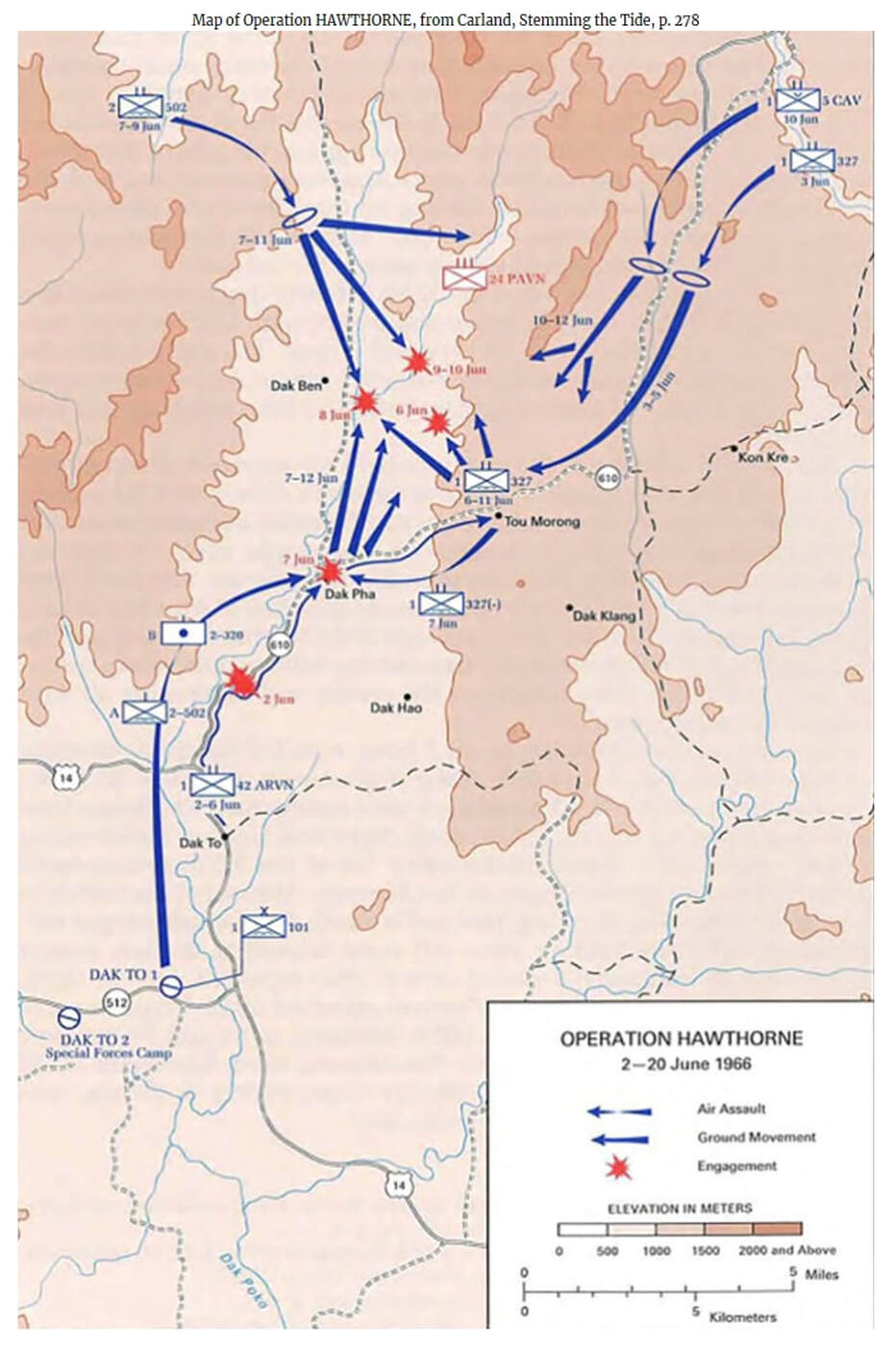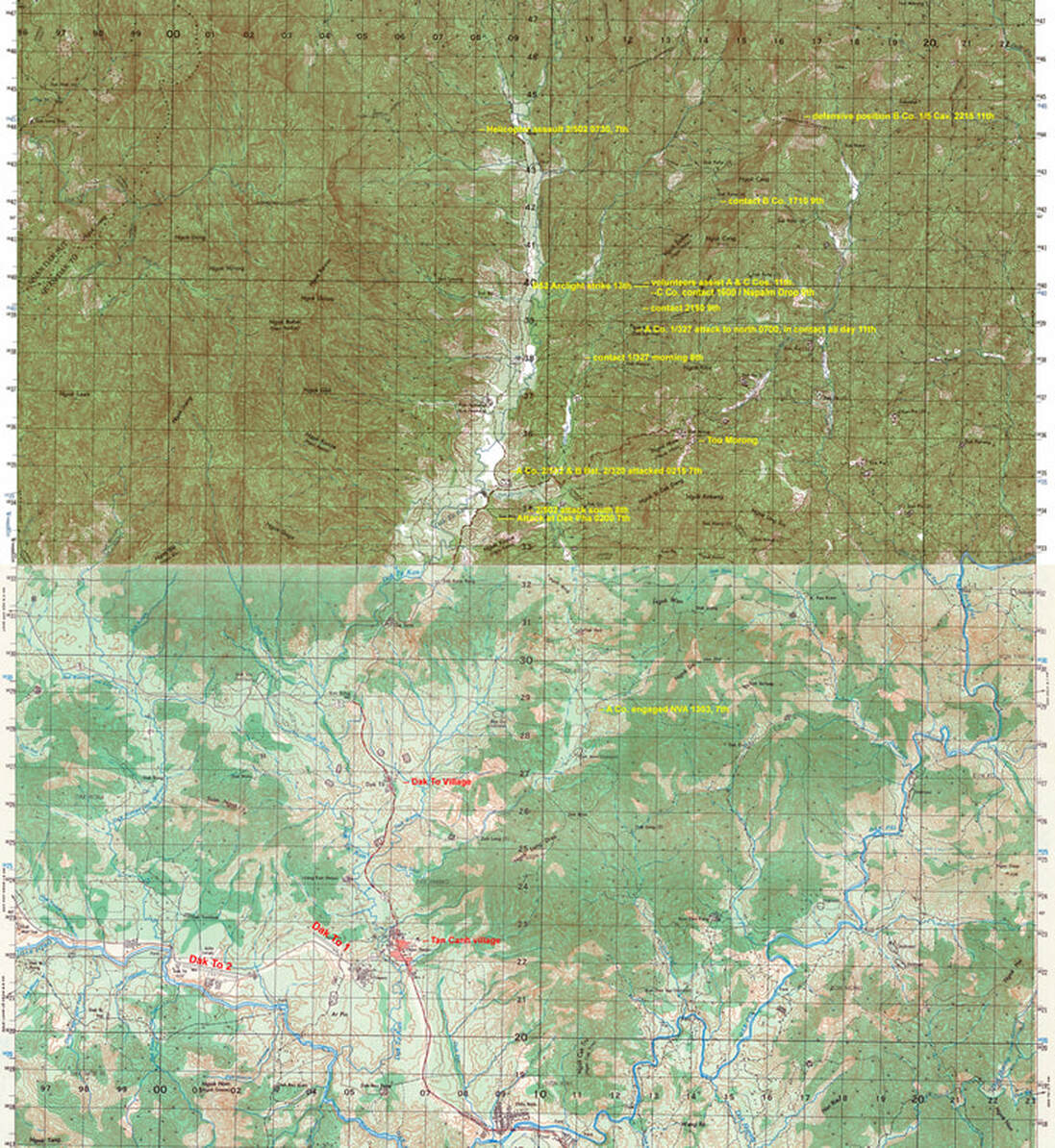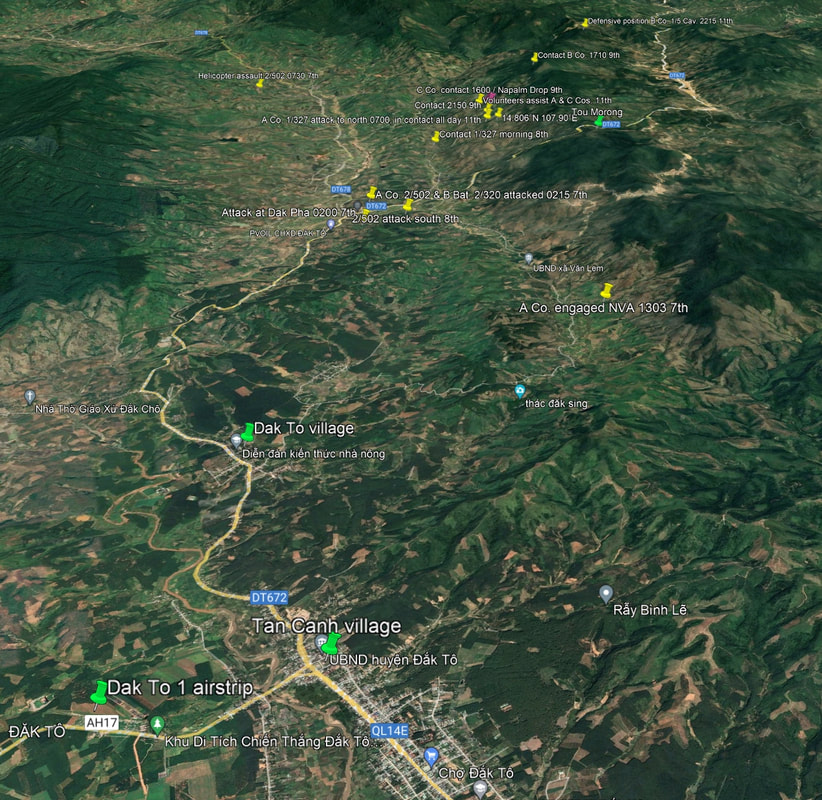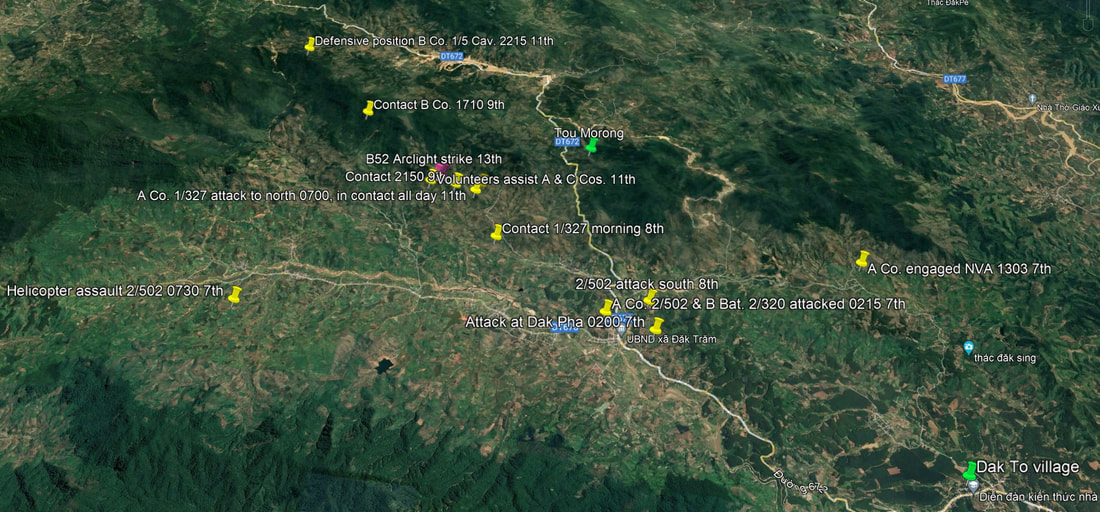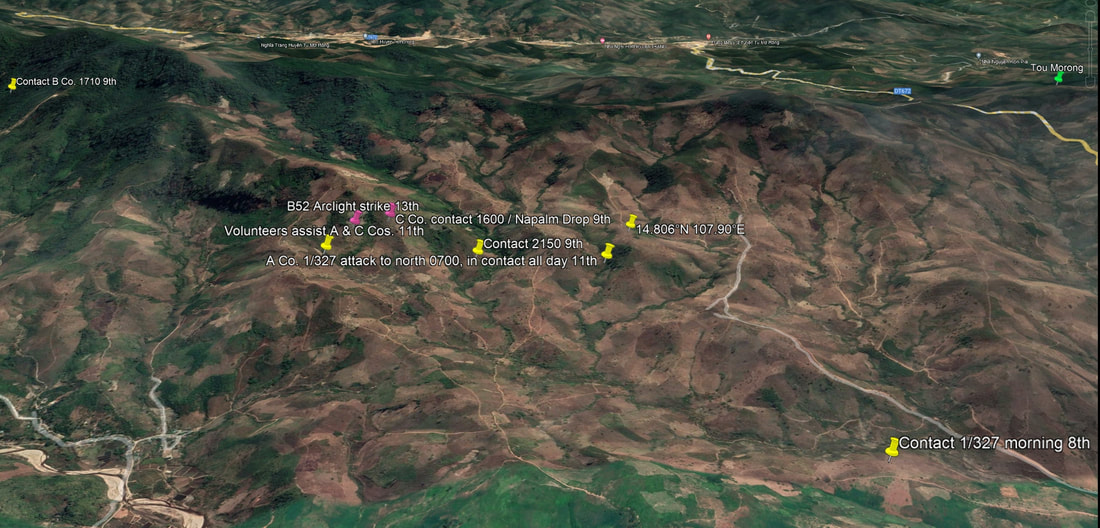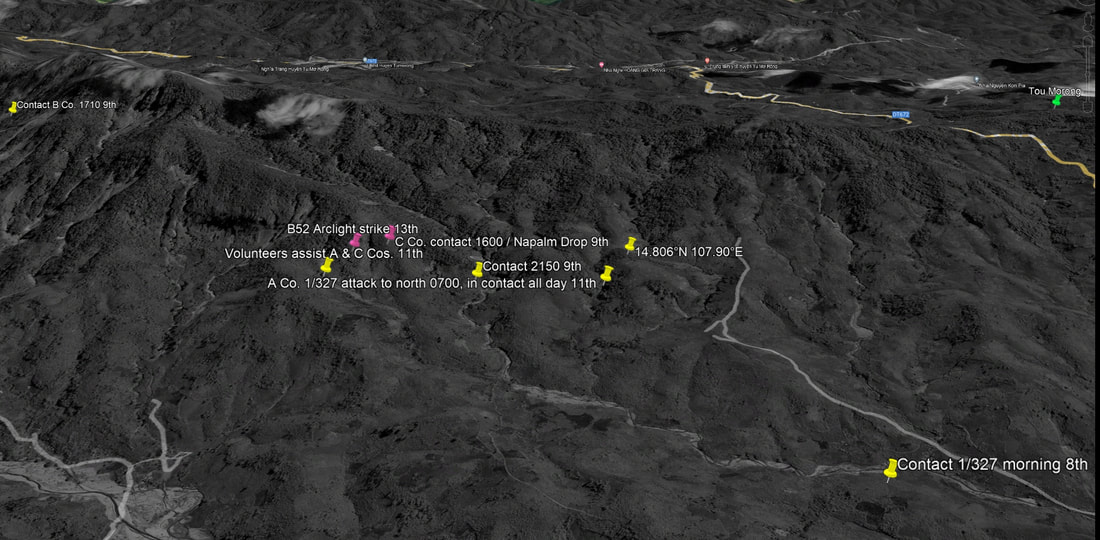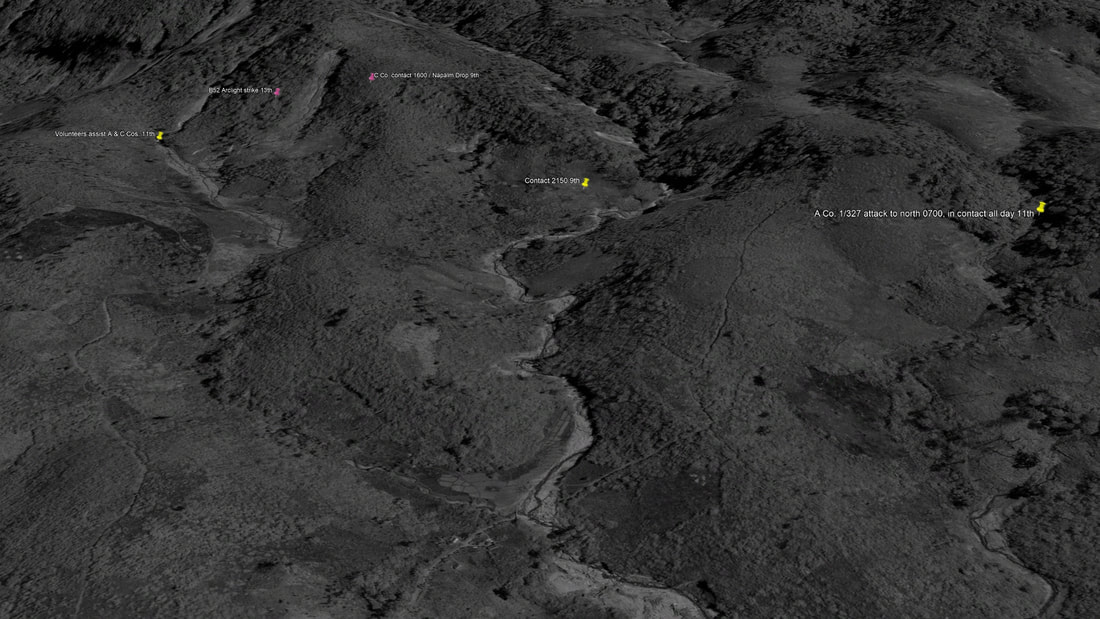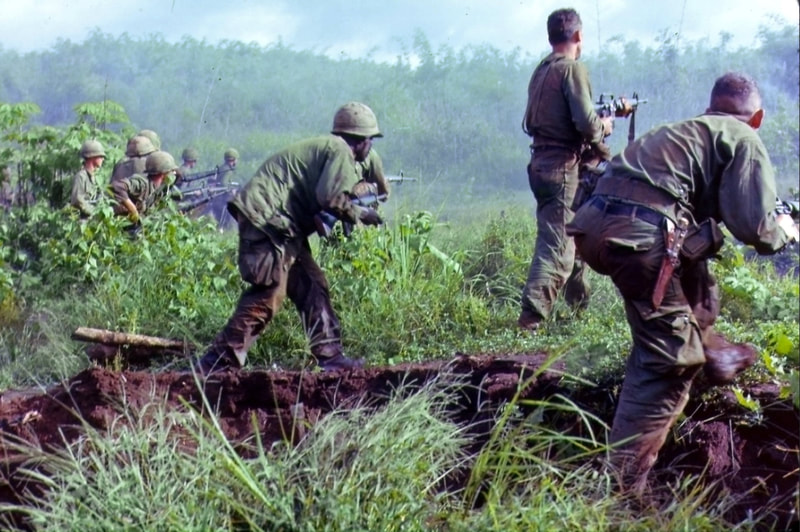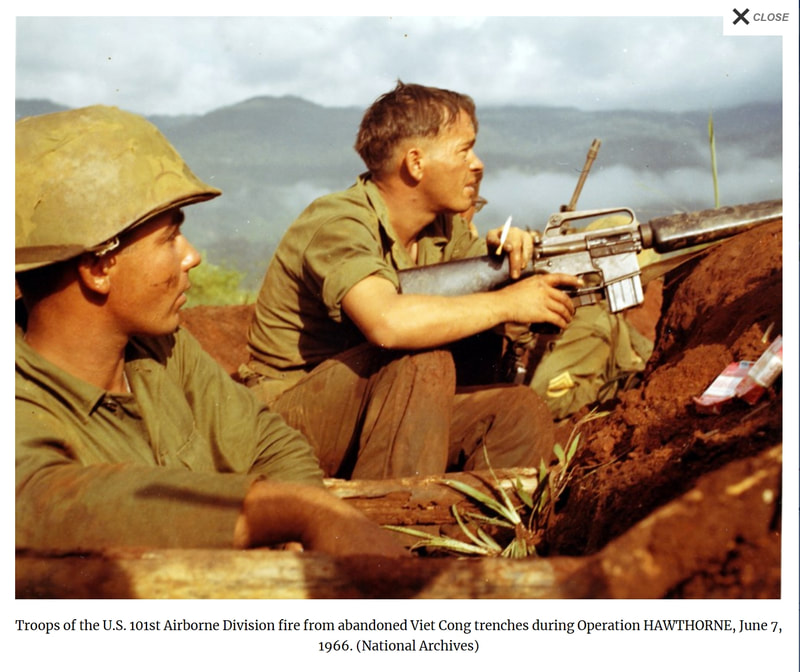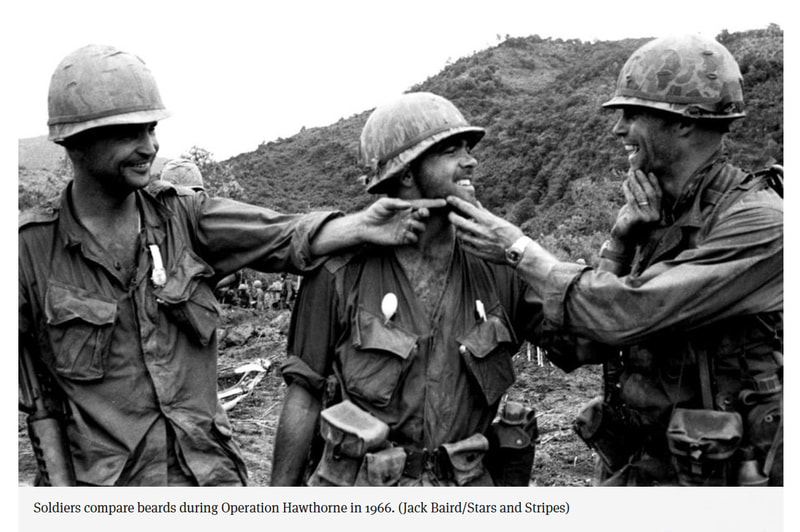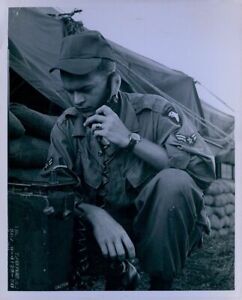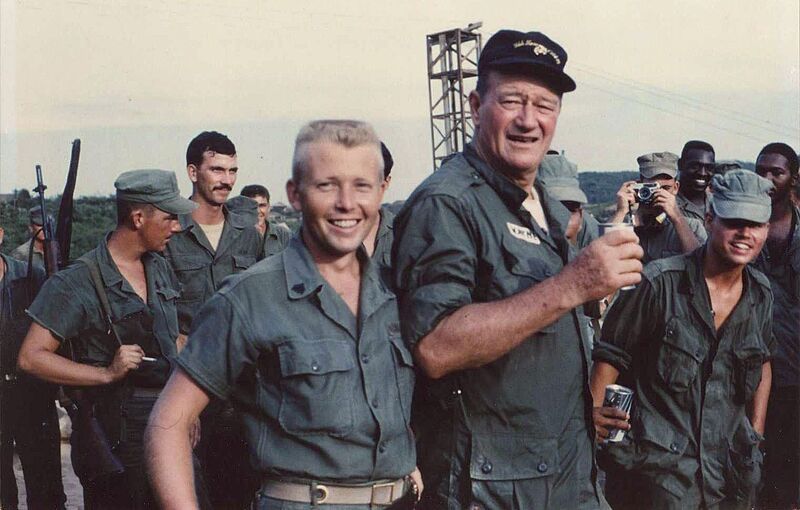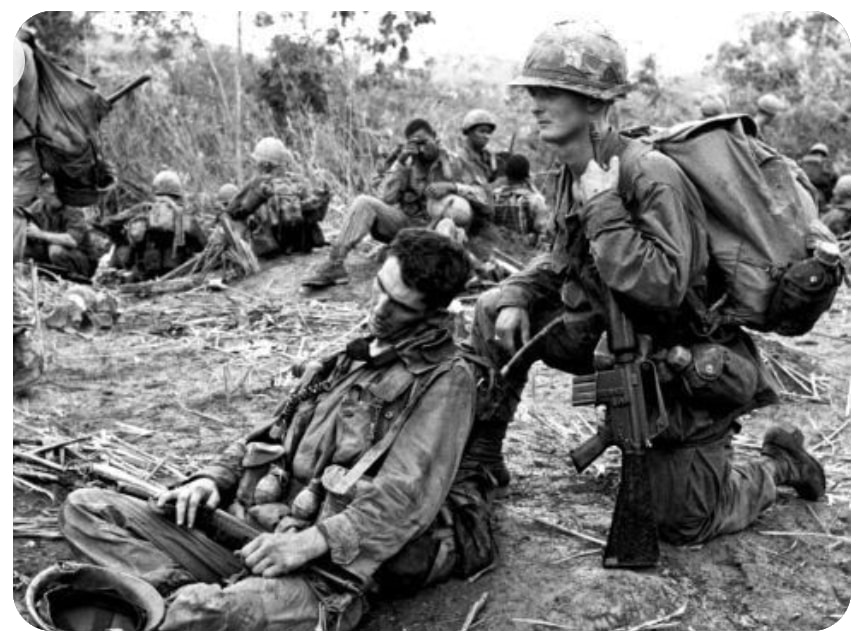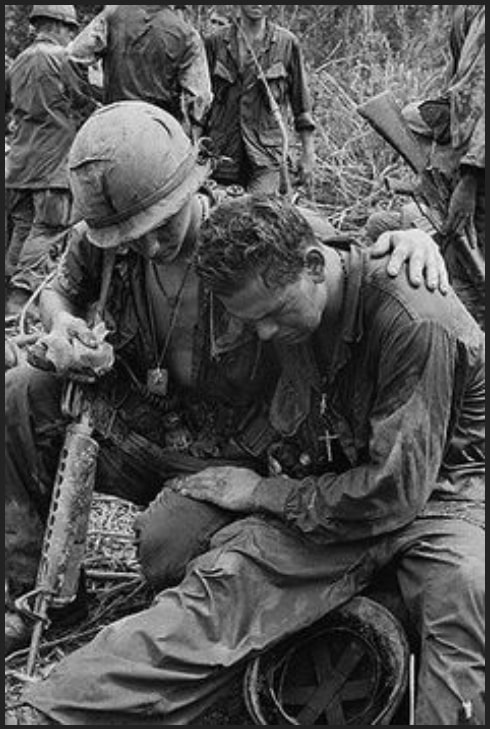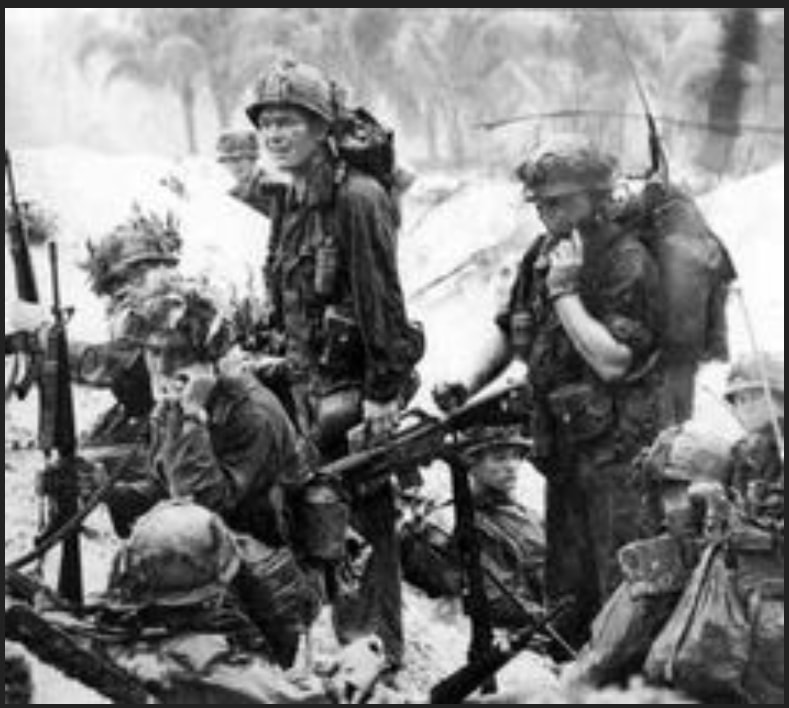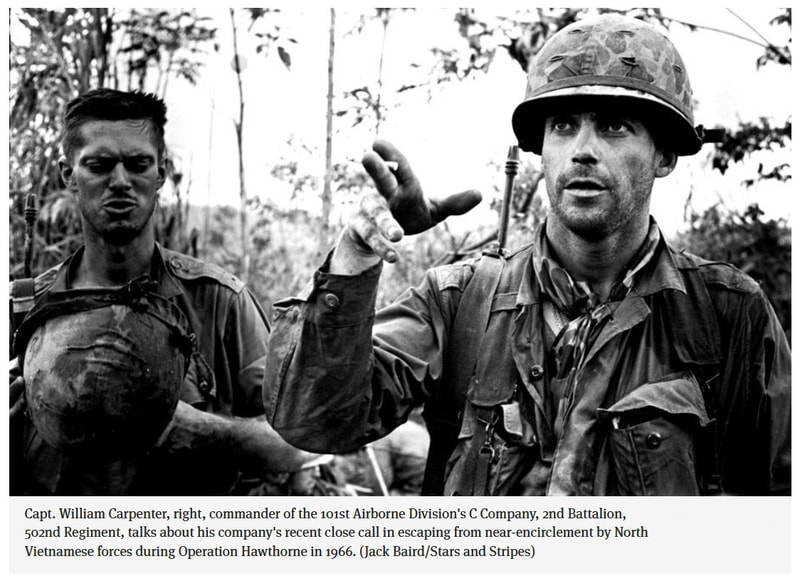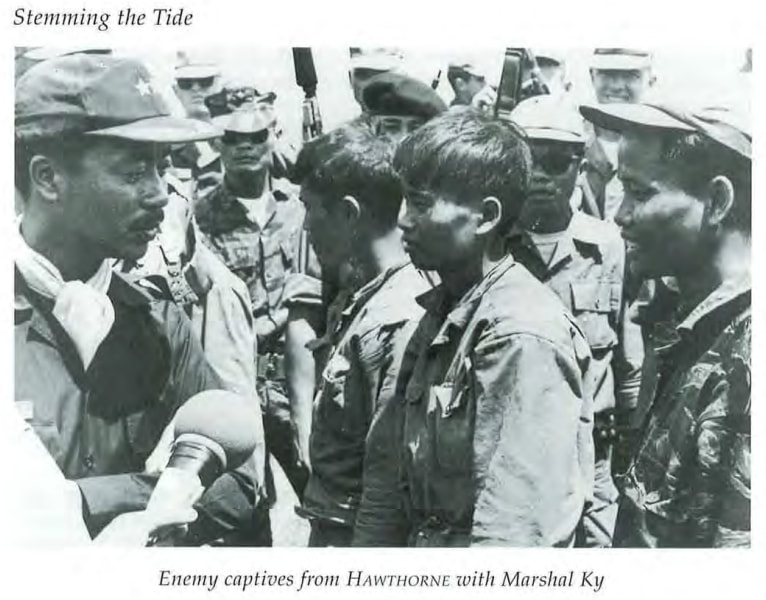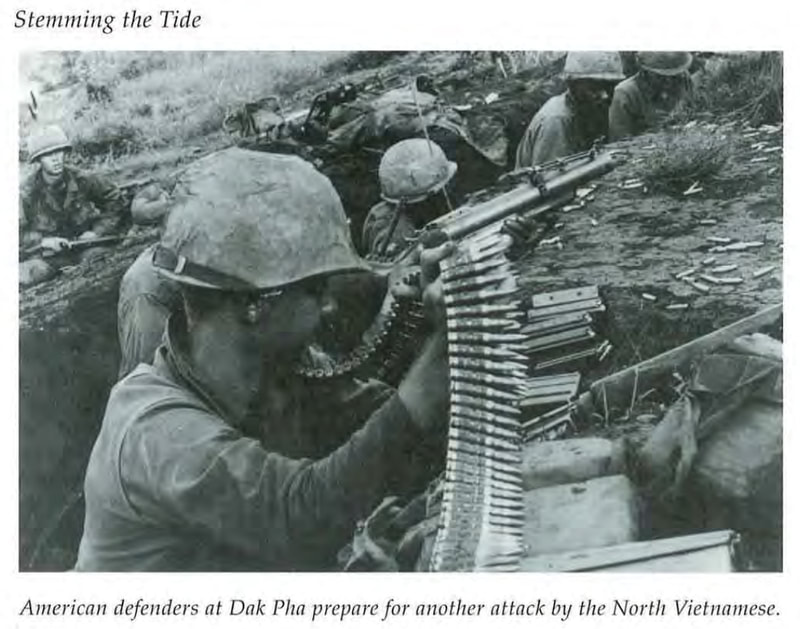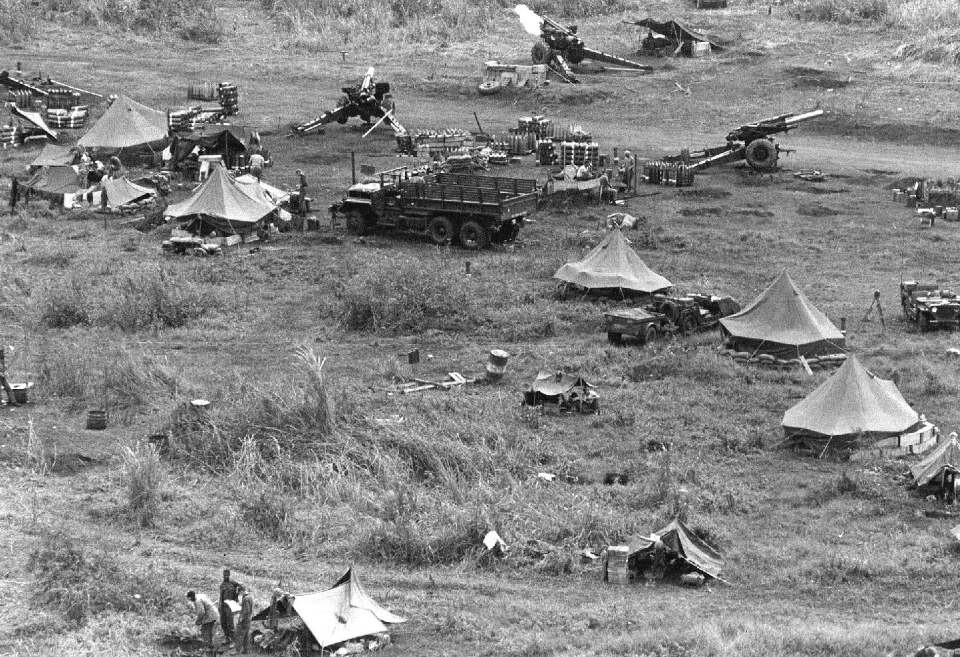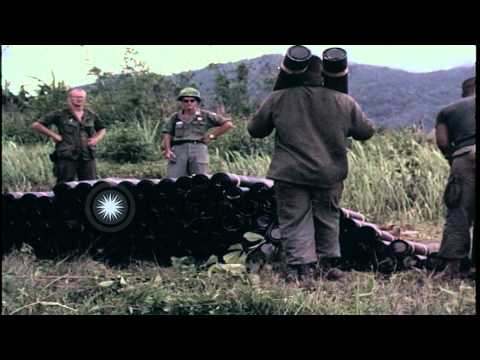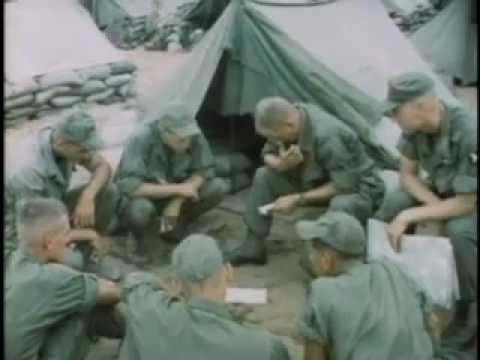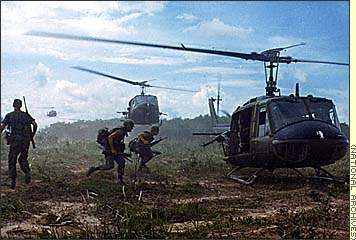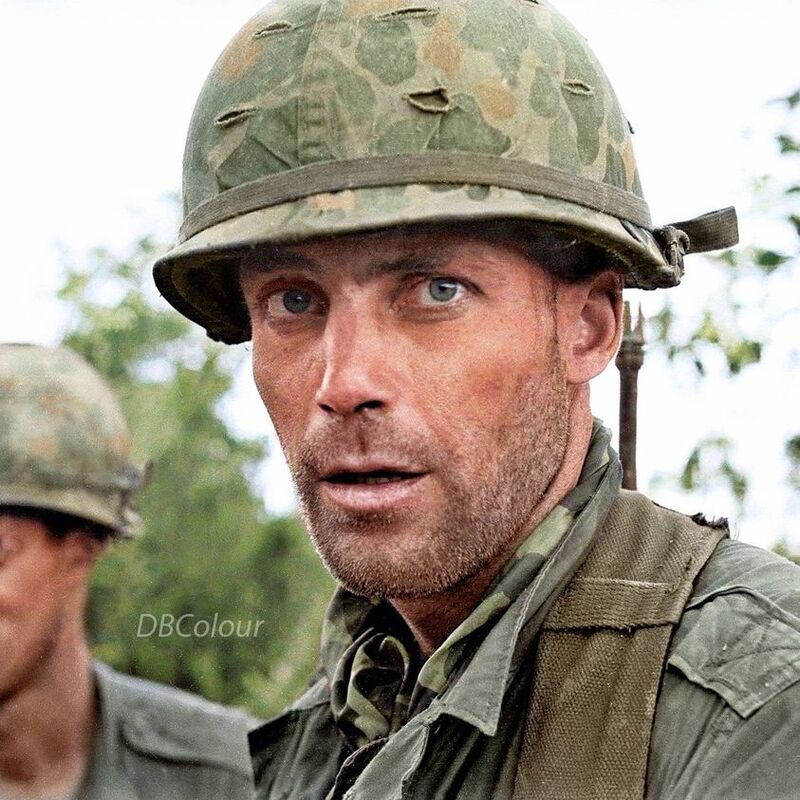Operation Hawthorne - June 02-21, 1966
Operation Hawthorne took place a year before I was at Dak To. It was run out of the Dak To 1 airstrip, east of Dak To 2, where subsequent action was centered.
I am hoping that men who were involved in Hawthorne will tell their stories and share their photos. In the meantime, I've found some reports and photos on the internet that I will collect here.
I am hoping that men who were involved in Hawthorne will tell their stories and share their photos. In the meantime, I've found some reports and photos on the internet that I will collect here.
First here are three descriptions of the operation:
------------------------------------------------------------------------
Operation HAWTHORNE begins. Its objective is to relieve a garrison of South Vietnamese Regional Forces, which has been surrounded by the North Vietnamese at a Special Forces camp near Dak To, Kontum Province.
Participants include elements of the 101st Airborne Division, two South Vietnamese battalions, and ample air support.
After the allied troops rescue the garrison, they pursue a skillful and aggressive North Vietnamese force. The North Vietnamese 24th Regiment is eventually pushed back and pinned in its fortified base area, where it is shattered by B-52 Arc Light strikes. Enemy forces finally withdraw, and HAWTHORNE ends on June 20.
John M. Carland, Stemming the Tide, May 1965–October 1966, United States Army in Vietnam (Washington, D.C.: Center of Military History, United States Army, 2000), 276–287.
--------------------------------------------------------------------------
2nd Bde, 101st ABN - Vietnam War History
OPERATION HAWTHORNE
Headquarters, I Field Force Vietnam directed the 1st Brigade, 101st Airborne Division (AM) to conduct search and destroy operation in the vicinity of DAK TO, TOU MORONG, TAN CHANH and assist in the withdrawal of the TOU MORONG Regional Force outpost.
The Brigade (-) began deployment from the CHEO REO area by C-130 aircraft on 29 May 1966 and closed into DAK TO on 03 June 1966. A total of 201 sorties were utilized. On 02 June, the 2-502 IN BN displaced from PLEIKU to DAK TO by CV-2 aircraft and convoy.
This operation was conducted in two phases. Phase I (02 June - 06 June 1966) consisted on a three pronged converging attack by the 1-327 IN BN, the 21st ARVN Ranger battalion and the 1-42 ARVN INF REGT to relieve the besieged Regional Force outpost at TOU MORONG. Phase II (06 June - 20 June 1996) consisted of a double envelopment of the enemy located in the ridges northeast of TOU MORONG by the 1-327 IN BN and 2-502 IN BN. Subsequently, the 1-42 ARVN INF REGT, B/2-327 IN and 1-5 CAV were inserted in an attempt to encircle the enemy, then identified as the 24th NVA REGT. A massive B-52 strike was then delivered on 13 June. Following the B-52 strike, and exploitation by airmobile and ground attack was launched, and search and destroy operations were conducted through 20 June 1966.
On 07 June, the 2-502 IN BN was released from IFFORCEV reserve and immediately deployed in an airmobile assault to envelop the enemy's northern flank. From 07 - 10 June, heavy contact was made with the enemy almost continuously as the 1-327 IN BN and 2-502 IN BN sought to dislodge the NVA forces from entrenched position in the dense bamboo jungle. Between 0820H and 0847H on 13 June, the B-52 strike was launched precisely on target. Following the strike, enemy resistance crumbled and the 1-327 IN BN, 2-502 IN BN, 1-5 CAV, 1-42 ARVN INF RGT and CIDG elements immediately exploited the objective area by helicopter and overland movement. Thirty minutes following the B-52 strike, one rifle company from 2-502 IN BN had been helilifted into the B-52 target area. Large number of VC KIA's weapons and equipment were found in the area. The 2-502 IN BN located and captured 15 dazed NVA personnel. On 15 June elements of the 2-502 IN BN and 1-5 CAV engaged a company size VC force north of the B-52 strike and the enemy broke contact following tactical air strikes.
(HQ, 1BDE, 101st ABN DIV; After Action Report, Operation HAWTHORNE, 22 July 1966)
Unit(s) tasked organized or under brigade control: 2-502 IN BN
Operation Hawthorne commenced on 02 June 1966 and terminated on 21 June 1966 with the following results:
Friendly: 48 KIA, 239 WIA
Enemy: 688 KIA, 506 (EST) KIA
notes: IN BN = Infantry Battalion. REGT=Regiment. CAV=Cavalry. ARVN=Army of Republic of Viet Nam. NVA=North Vietnamese Army. CIDG=Civilian Irregular Defense Group (Montagnards). VC=Viet Cong (guerillas). KIA=Killed In Action.
--------------------------------------------------------------------------
Week of June 23
On June 20, 1966, U.S. and South Vietnamese troops concluded Operation HAWTHORNE after nearly three weeks of heavy fighting. It was an operation in Kontum Province during a year of the war in which U.S. forces broadly took the offensive against Communist troops for the first time. The original goal of Operation HAWTHORNE was to relieve a garrison of South Vietnamese Regional Forces that had been surrounded near Đăk Tô. But captured intelligence suggesting an imminent North Vietnamese offensive in the province led to HAWTHORNE’s expansion in order to spoil Hà Nội’s attack plan.
In late May 1966, at an outpost in northern Kon Tum Province named Tou Morong, North Vietnamese troops surrounded a group of South Vietnamese Regional Forces, cutting off their escape routes. The defenders of Tou Morong remained pinned down by mortar and sniper fire for several days, but their position was not overrun. This was likely because the North Vietnamese intended the attack on Tou Morong as a distraction (as captured intelligence soon indicated) for an imminent offensive by the North Vietnamese 88th and 24th Regiments, which were lurking nearby. If the larger attack had been launched, it would have been one of the first major North Vietnamese offensive operations since the arrival of American combat troops.
If a plan for an offensive existed, however, allied forces spoiled it. In response to the Tou Morong attack, the U.S. Army launched Operation HAWTHORNE on June 2, to relieve Tou Morong and to counter any notion Communist troops might have had of a wider attack in Kon Tum.
Operation HAWTHORNE began on June 2, 1966. Participating forces included: the 1st Brigade, 101st Airborne Division; a South Vietnamese infantry battalion; and the South Vietnamese 21st Ranger Battalion. These units were later joined by the U.S. 502d Infantry Regiment. HAWTHORNE’s forces moved into a region of mountainous thick jungle with few serviceable roads, aiming to destroy the North Vietnamese 24th Regiment from three sides (the 88th Regiment was still waiting across the border, in Laos). The allied forces reached the surrounded men at Tou Morong relatively quickly, relieving them on June 5.
American commanders decided to see if they could track down the North Vietnamese before they left the region. After a short pursuit, a series of major engagements and minor skirmishes occurred between allied troops and the North Vietnamese 24th Regiment over the following days, as U.S. and South Vietnamese forces, now joined by the 502d Infantry, pushed north and west through the jungle. The Communist forces retreated into a prepared defensive position and readied themselves for a long fight. But, after U.S. attacks triangulated the North Vietnamese’s precise position, American commanders requested a B-52 strike. On June 13, an Arc Light strike force of U.S. Air Force B-52s dropped nearly 650 tons of bombs on the North Vietnamese 24th Infantry Regiment and its fortified base area. A follow up ground attack found that the Communist forces had been devastated.
After several days of further skirmishes, Operation HAWTHORNE ended on June 20, having chased the remaining Communist soldiers into Laos and perhaps ending a North Vietnamese offensive before it began. Later estimates indicated that the 24th Regiment had sustained a casualty rate of 60 percent, and because of this U.S. leaders judged HAWTHORNE a success, though the North Vietnamese Regiment was back to fighting strength by early 1967. American casualties in HAWTHORNE included 48 killed, and 239 wounded.
John M. Carland, United States Army in Vietnam: Combat Operations: Stemming the Tide, May 1965 to October 1966 (Wash DC: Center of Military History, 2000), 276–88; Spencer C. Tucker, The Encyclopedia of the Vietnam War: A Political, Social, and Military History (2nd edition; Santa Barbara, CA: ABC-CLIO, 2011), 465–66.
------------------------------------------------------------------------
Operation HAWTHORNE begins. Its objective is to relieve a garrison of South Vietnamese Regional Forces, which has been surrounded by the North Vietnamese at a Special Forces camp near Dak To, Kontum Province.
Participants include elements of the 101st Airborne Division, two South Vietnamese battalions, and ample air support.
After the allied troops rescue the garrison, they pursue a skillful and aggressive North Vietnamese force. The North Vietnamese 24th Regiment is eventually pushed back and pinned in its fortified base area, where it is shattered by B-52 Arc Light strikes. Enemy forces finally withdraw, and HAWTHORNE ends on June 20.
John M. Carland, Stemming the Tide, May 1965–October 1966, United States Army in Vietnam (Washington, D.C.: Center of Military History, United States Army, 2000), 276–287.
--------------------------------------------------------------------------
2nd Bde, 101st ABN - Vietnam War History
OPERATION HAWTHORNE
Headquarters, I Field Force Vietnam directed the 1st Brigade, 101st Airborne Division (AM) to conduct search and destroy operation in the vicinity of DAK TO, TOU MORONG, TAN CHANH and assist in the withdrawal of the TOU MORONG Regional Force outpost.
The Brigade (-) began deployment from the CHEO REO area by C-130 aircraft on 29 May 1966 and closed into DAK TO on 03 June 1966. A total of 201 sorties were utilized. On 02 June, the 2-502 IN BN displaced from PLEIKU to DAK TO by CV-2 aircraft and convoy.
This operation was conducted in two phases. Phase I (02 June - 06 June 1966) consisted on a three pronged converging attack by the 1-327 IN BN, the 21st ARVN Ranger battalion and the 1-42 ARVN INF REGT to relieve the besieged Regional Force outpost at TOU MORONG. Phase II (06 June - 20 June 1996) consisted of a double envelopment of the enemy located in the ridges northeast of TOU MORONG by the 1-327 IN BN and 2-502 IN BN. Subsequently, the 1-42 ARVN INF REGT, B/2-327 IN and 1-5 CAV were inserted in an attempt to encircle the enemy, then identified as the 24th NVA REGT. A massive B-52 strike was then delivered on 13 June. Following the B-52 strike, and exploitation by airmobile and ground attack was launched, and search and destroy operations were conducted through 20 June 1966.
On 07 June, the 2-502 IN BN was released from IFFORCEV reserve and immediately deployed in an airmobile assault to envelop the enemy's northern flank. From 07 - 10 June, heavy contact was made with the enemy almost continuously as the 1-327 IN BN and 2-502 IN BN sought to dislodge the NVA forces from entrenched position in the dense bamboo jungle. Between 0820H and 0847H on 13 June, the B-52 strike was launched precisely on target. Following the strike, enemy resistance crumbled and the 1-327 IN BN, 2-502 IN BN, 1-5 CAV, 1-42 ARVN INF RGT and CIDG elements immediately exploited the objective area by helicopter and overland movement. Thirty minutes following the B-52 strike, one rifle company from 2-502 IN BN had been helilifted into the B-52 target area. Large number of VC KIA's weapons and equipment were found in the area. The 2-502 IN BN located and captured 15 dazed NVA personnel. On 15 June elements of the 2-502 IN BN and 1-5 CAV engaged a company size VC force north of the B-52 strike and the enemy broke contact following tactical air strikes.
(HQ, 1BDE, 101st ABN DIV; After Action Report, Operation HAWTHORNE, 22 July 1966)
Unit(s) tasked organized or under brigade control: 2-502 IN BN
Operation Hawthorne commenced on 02 June 1966 and terminated on 21 June 1966 with the following results:
Friendly: 48 KIA, 239 WIA
Enemy: 688 KIA, 506 (EST) KIA
notes: IN BN = Infantry Battalion. REGT=Regiment. CAV=Cavalry. ARVN=Army of Republic of Viet Nam. NVA=North Vietnamese Army. CIDG=Civilian Irregular Defense Group (Montagnards). VC=Viet Cong (guerillas). KIA=Killed In Action.
--------------------------------------------------------------------------
Week of June 23
On June 20, 1966, U.S. and South Vietnamese troops concluded Operation HAWTHORNE after nearly three weeks of heavy fighting. It was an operation in Kontum Province during a year of the war in which U.S. forces broadly took the offensive against Communist troops for the first time. The original goal of Operation HAWTHORNE was to relieve a garrison of South Vietnamese Regional Forces that had been surrounded near Đăk Tô. But captured intelligence suggesting an imminent North Vietnamese offensive in the province led to HAWTHORNE’s expansion in order to spoil Hà Nội’s attack plan.
In late May 1966, at an outpost in northern Kon Tum Province named Tou Morong, North Vietnamese troops surrounded a group of South Vietnamese Regional Forces, cutting off their escape routes. The defenders of Tou Morong remained pinned down by mortar and sniper fire for several days, but their position was not overrun. This was likely because the North Vietnamese intended the attack on Tou Morong as a distraction (as captured intelligence soon indicated) for an imminent offensive by the North Vietnamese 88th and 24th Regiments, which were lurking nearby. If the larger attack had been launched, it would have been one of the first major North Vietnamese offensive operations since the arrival of American combat troops.
If a plan for an offensive existed, however, allied forces spoiled it. In response to the Tou Morong attack, the U.S. Army launched Operation HAWTHORNE on June 2, to relieve Tou Morong and to counter any notion Communist troops might have had of a wider attack in Kon Tum.
Operation HAWTHORNE began on June 2, 1966. Participating forces included: the 1st Brigade, 101st Airborne Division; a South Vietnamese infantry battalion; and the South Vietnamese 21st Ranger Battalion. These units were later joined by the U.S. 502d Infantry Regiment. HAWTHORNE’s forces moved into a region of mountainous thick jungle with few serviceable roads, aiming to destroy the North Vietnamese 24th Regiment from three sides (the 88th Regiment was still waiting across the border, in Laos). The allied forces reached the surrounded men at Tou Morong relatively quickly, relieving them on June 5.
American commanders decided to see if they could track down the North Vietnamese before they left the region. After a short pursuit, a series of major engagements and minor skirmishes occurred between allied troops and the North Vietnamese 24th Regiment over the following days, as U.S. and South Vietnamese forces, now joined by the 502d Infantry, pushed north and west through the jungle. The Communist forces retreated into a prepared defensive position and readied themselves for a long fight. But, after U.S. attacks triangulated the North Vietnamese’s precise position, American commanders requested a B-52 strike. On June 13, an Arc Light strike force of U.S. Air Force B-52s dropped nearly 650 tons of bombs on the North Vietnamese 24th Infantry Regiment and its fortified base area. A follow up ground attack found that the Communist forces had been devastated.
After several days of further skirmishes, Operation HAWTHORNE ended on June 20, having chased the remaining Communist soldiers into Laos and perhaps ending a North Vietnamese offensive before it began. Later estimates indicated that the 24th Regiment had sustained a casualty rate of 60 percent, and because of this U.S. leaders judged HAWTHORNE a success, though the North Vietnamese Regiment was back to fighting strength by early 1967. American casualties in HAWTHORNE included 48 killed, and 239 wounded.
John M. Carland, United States Army in Vietnam: Combat Operations: Stemming the Tide, May 1965 to October 1966 (Wash DC: Center of Military History, 2000), 276–88; Spencer C. Tucker, The Encyclopedia of the Vietnam War: A Political, Social, and Military History (2nd edition; Santa Barbara, CA: ABC-CLIO, 2011), 465–66.
Here are some more descriptions of the Hawthorne Operation. I've put them in their own pages. Click on the links to view them.
Screaming Eagles - Operation Hawthorne
101st Presidential Citation for Operation Hawthorne
Stars and Stripes article of June 13, 1966
After-Action report, with details and coordinates
After Action report - 1st Brigade 101st Airborne Division
Mike Baldinger's description of the battle
Wikipedia description of Operation Hawthorne
Stemming the Tide - Combat Operations May 1965 to Oct. 1966 - book by John M. Carland. Hawthorne starts on page 275
David H. Hackworth - Citation and Obituary
Screaming Eagles - Operation Hawthorne
101st Presidential Citation for Operation Hawthorne
Stars and Stripes article of June 13, 1966
After-Action report, with details and coordinates
After Action report - 1st Brigade 101st Airborne Division
Mike Baldinger's description of the battle
Wikipedia description of Operation Hawthorne
Stemming the Tide - Combat Operations May 1965 to Oct. 1966 - book by John M. Carland. Hawthorne starts on page 275
David H. Hackworth - Citation and Obituary
Topo map showing the area of Operation Hawthorne. To get a higher resolution image, Click Here
Google Earth image of the area as it is today in 2023
Closer view of the main battle area, as it is today in 2023
Still closer view of the main battle area, as it is today in 2023
Same view as above, but the image is from 2010 when jungle vegetation was still in place
Still closer view of 2010 image.
The placemarks here were located using the topo map and coordinates from the after-action report. I then overlaid the map on Google Earth to create the placemarks. They should be pretty close to the accurate locations. Please let me know if any should be moved.
Here are some photos I found on the internet. Please let me know if these are not from Hawthorne, or if you have photos to add.
A remembrance found on the Facebook Central Highlands Veterans page
Dominick Fondo
July 5, 2022
·
During the month of June 1966 will always bring a flood of tears and memories of those that fell in a God forsaken place called Dak-to Viet Nam.
On June 7th we were a few clicks from Dak To. We, the 3rd Plt. Abu 1/327, were sent into a valley to recon when all hell broke loose. Sgt. Ira Perkins, one of the best Sgts, was killed. We had stepped into a deadly horseshoe ambush by an NVA unit. Soon thereafter my asst. gunner and ammo bearer were hit. I told them to try to make it back to the Company. For some reason, Hackworth and Willis would NOT COMMIT the company to our aid. I was soon alone, firing into the NVA, when a Black soldier by the name of Waddel (Waddy) came busting through the brush behind me yelling "Fondo, lets go, the heavies are on their way!
Waddy saved my life. As I found out later, he (Waddy) was told to not try to get to me. Willis told him it was too late. Had Waddy not came down for me, I would have been a crispy critter.
Soon thereafter we heard that the 502 was in danger of being overrun. We ran for the better part of a day and night trying to bring relief to them when about 20:00 hrs. we became engaged by the NVA 24th re-enforce regiment. Thus, the battle for Dak To raged for another two weeks of solid fighting. The Battle was indeed ferocious. After I was hit, I was helping our Medic. One man that stands out in my mind was a young soldier named Goodall. We tried our best but there was nothing we could do. To this day his eyes still haunt me. We won that battle but at a terrible cost. I understand that Dak To is now a pineapple plantation. Like so many others, Viet Nam will live with me, for however long I live, as will those that died alongside me!
July 5, 2022
·
During the month of June 1966 will always bring a flood of tears and memories of those that fell in a God forsaken place called Dak-to Viet Nam.
On June 7th we were a few clicks from Dak To. We, the 3rd Plt. Abu 1/327, were sent into a valley to recon when all hell broke loose. Sgt. Ira Perkins, one of the best Sgts, was killed. We had stepped into a deadly horseshoe ambush by an NVA unit. Soon thereafter my asst. gunner and ammo bearer were hit. I told them to try to make it back to the Company. For some reason, Hackworth and Willis would NOT COMMIT the company to our aid. I was soon alone, firing into the NVA, when a Black soldier by the name of Waddel (Waddy) came busting through the brush behind me yelling "Fondo, lets go, the heavies are on their way!
Waddy saved my life. As I found out later, he (Waddy) was told to not try to get to me. Willis told him it was too late. Had Waddy not came down for me, I would have been a crispy critter.
Soon thereafter we heard that the 502 was in danger of being overrun. We ran for the better part of a day and night trying to bring relief to them when about 20:00 hrs. we became engaged by the NVA 24th re-enforce regiment. Thus, the battle for Dak To raged for another two weeks of solid fighting. The Battle was indeed ferocious. After I was hit, I was helping our Medic. One man that stands out in my mind was a young soldier named Goodall. We tried our best but there was nothing we could do. To this day his eyes still haunt me. We won that battle but at a terrible cost. I understand that Dak To is now a pineapple plantation. Like so many others, Viet Nam will live with me, for however long I live, as will those that died alongside me!
